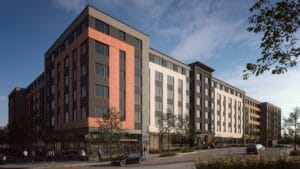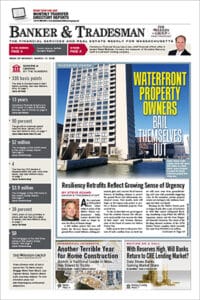
Boston-area communities continue to press developers to include more affordable units in multifamily projects without raising requirements to unprofitable thresholds. Greystar broke ground last month on the 85 Boston St. project in Everett, which will include 33 affordable units in a 650-unit complex. Image courtesy of The Architectural Team
It’s a pivotal policy question for Massachusetts communities seeking to encourage affordable housing in new developments: What’s the highest percentage of affordable units that can be required before projects become financially unfeasible?
In Boston, Acting Mayor Kim Janey recently said she’s open to raising the minimum requirement of 13 percent income-restricted units in developments with 10 or more units outside of the commercial core. Cambridge and Somerville raised their affordable unit minimums to 20 percent in recent years. Malden officials are reviewing the city’s first-ever inclusionary zoning policy after a building boom brought approximately 2,000 market-rate units to the downtown in recent years.
“Inclusionary zoning is not an end-all solution to affordability,” said Jeff Levine, a Massachusetts Institute of Technology lecturer and planning consultant. “It’s one tool. 20 percent [of total units] is about as high as it can work well before it really does start impacting the market.”
15 Percent at 50 Percent AMI
Malden’s proposed, first-ever inclusionary zoning adds new requirements as well as incentives for multifamily developers. Projects with eight or more units would be required to include 15 percent income-restricted units on-site or pay a $300,000 fee per unit to the city’s two-year-old affordable housing trust fund. Affordable apartments would be reserved for households earning a maximum 50 percent of area median income, currently $48,125 for a two-person household.
“We were being pretty aggressive and going for the deep affordability, but we wanted to keep it simple and reasonable,” said Evan Petrini, senior planner and policy manager for the Malden Office of Strategic Planning and Community Development.
Affordable condominium units would be reserved for households making up to 80 percent of AMI, or $77,000 for a two-person household, reflecting the higher returns expected in for-sale developments.
As a trade-off, developers would get a density bonuses amounting to one additional unit for every income-restricted unit in a project.
“There isn’t a one-size-fits-all approach, but in general, having a density bonus as part of a policy is helpful in terms of offsetting some of the [developer’s] internal costs,” Levine said.
Levine Planning Strategies and Colliers International recommended three options to Malden – including the one currently under review – based upon an analysis of several theoretical apartment and condo projects ranging from 15 to 50 units.
The study assumed that apartment developers need to achieve a return on equity of 4 to 5 percent to turn a profit, while condo developers are looking for 40 to 50 percent. Lowering the income qualifications from 50 to 30 percent of AMI rendered projects infeasible, the study determined.
After receiving a unanimous recommendation from the Planning Board, the Malden zoning amendment will be reviewed by the City Council in September.
One Piece of a Housing Puzzle
Analysts say most communities’ inclusionary policies are neither a cure-all for the housing affordability crisis, nor a death knell to developers’ ability to finance projects. Other factors play significant roles in how much multifamily gets built in a community: land costs, competition from developers of other property types, and underlying zoning rules about height and density.
Some research indicates that land prices decline after affordability requirements are raised, Levine said.
“That doesn’t happen overnight. There is a transition period,” he said. “That’s where a carefully written ordinance can phase that in.”
Somerville increased its minimum affordable percentage to what was then a nation-leading 20 percent for projects with 18 or more units in 2016. Completed new housing units peaked at 525 in 2018 before declining to 191, 126 and 49 in the ensuing years, according to the city’s SomerVision database of certificates of occupancy.
But inclusionary zoning appears to be only one factor in the city’s recent development patterns. Somerville, like Boston, has become prime territory for life science developers who routinely outbid housing specialists for sites. Virtually all of the projects now under review in development hotspots such as Union Square, Boynton Yards and Brickbottom are office-lab buildings.
(sub) Requirements Change in Amid Everett Boom
Everett approved a minimum 15 percent affordability component in multifamily developments in 2017, amid warnings from some elected officials that it would stifle housing development. The policy was amended in 2018 to require only 5 percent affordable units on properties that have activity and use limitations, a document recorded at the Registry of Deeds that indicates the presence of environmental contamination and also called an AUL.

Steve Adams
That was a significant change, as many of the best development parcels are former scrapyards and automotive-related uses located in the city’s commercial triangle zone off Revere Beach Parkway.
More than 3,000 housing units are under review or under construction in Everett, with most of the larger projects subject to the lower affordability threshold.
But Mayor Carlo DeMaria is now asking the City Council to revisit the 5 percent requirement. The administration is proposing that the city Planning Board be given the discretion to reduce the affordability percentage to a minimum 10 percent in properties with recorded contamination, according to Matthew Lattanzi, assistant city solicitor and acting director of planning and development.
John Tocco, who is partnering with Volnay Capital on the recently-approved Sky Everett apartment tower, said the project wouldn’t have been feasible under higher affordability requirements.
“Solving housing affordability is an admirable goal, but adding costs to projects is not the way to accomplish it,” Tocco said. “We have to stretch the market-rate units’ rental rates to cover the rest of the building and make sure the numbers work.”




